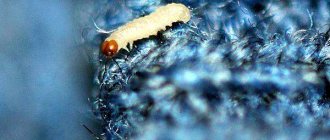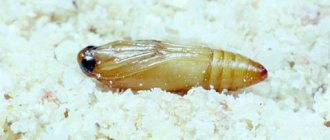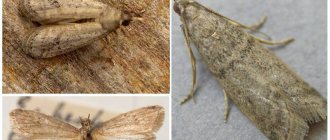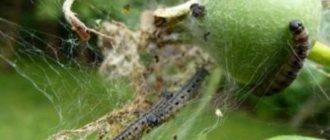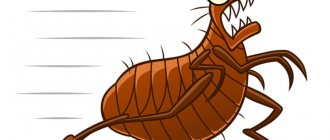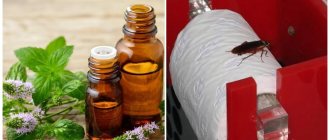Direct and indirect harm
When assessing the danger of moths appearing in an apartment, they first of all talk about spoiled products and things. This is direct harm, but there is also indirect harm. So, having discovered a food moth in a bag of flour, most housewives will throw away not only it, but also all nearby products, since they may also contain insects that have gone unnoticed.
As for clothes moths, indirect harm can be caused when trying to cope with them. For example, washing woolen items in hot water may cause them to change shape or size. The same applies to the use of untested means that can ruin the item.
Clothes
But the question of whether moths are dangerous for people is inappropriate in this case. The insect does not bite, does not carry pathogens, and therefore poses no direct harm to humans.
The benefits and harms of moths
What role does a moth play in nature? It is one of the components of the cycle of substances in the natural environment. Moths destroy and recycle the horny and hairy components of the world around us. She, in turn, is food for birds and small
mammals.
But what about the person? Is it really possible that this insect can’t bring anything other than frustration from spoiled food, clothes and furniture? It turns out it can.
Wax moth larvae are beneficial to humans. The caterpillars of this moth live in hives and feed on wax. Back in the 17th century, people noticed that an extract obtained from wax moth larvae helped cure tuberculosis. Who knows, maybe in the future other useful properties for humans of the moth we all know will be revealed.
Do moths eat and what do they eat?
Adults, that is, those gray-brown moths that are sometimes found in the room or kitchen, do not eat anything. They live off the nutrients that were accumulated at the larval stage, and their main task is to have time to lay eggs. But larvae (small white worms) are the same pests that actively destroy food and clothing.
What do food moths like in the kitchen?
Food moth is a common name for several types of insects that can live in the kitchen, feeding on various foods.
So, what does food moth eat:
- flour;
- cereals and grains;
- nuts and seeds;
- dried fruits;
- chocolate and candies;
- pasta;
- cookies, biscuits, crackers.
Each species prefers a certain product, but if necessary, it can eat something else. For example, fruit moths will not refuse cereals or cookies due to the lack of dried fruits.
Do food moths ruin clothes?
Despite the fact that all types of domestic moths are similar to each other, their food preferences are different. Food moth larvae will not eat clothing, just as the clothing or carpet varieties will not cause any harm to food.
What do clothes moths eat in the apartment?
If there are clothes moths in your apartment, they can ruin a lot of things. The following are at risk:
- products made from natural fur (sheepskin coats, fur coats, hats, fur collars on coats and jackets);
- items made of wool, linen, cotton, silk;
- shoes with fur or wool insulation;
- felt boots, felt woolen slippers;
- carpets and rugs;
- furniture upholstery.
There is an opinion that moths only eat clothes made from natural materials such as wool or cotton. But, unfortunately, insects adapt to the conditions in which they live, so semi-synthetic and even synthetic things are increasingly suffering from pests.
Insect species
There are about 40 species of moths in our environment. But only a few give us special trouble, for example clothes moths, grain moths, furniture moths and mushroom moths.
Clothes
The clothes moth is a butterfly with a wingspan of up to 12 mm. The wings are light yellow in color, turning purple-brown towards the base of the body. Clothes moth caterpillars are white, have eight short legs on their abdomen, and the skin on the body of the caterpillars is translucent, which allows you to see the contents of the stomach.
The clothes moth caterpillar lives in a stationary case, which is located in the folds of woolen and drape clothing. At the same time, the larva eats away large holes in the habitat. Female clothes moths practically cannot fly; they only crawl on clothes; only males fly. In a city apartment, clothes moths can reproduce throughout the year.
Furniture
For a very long time, furniture moths and clothes moths were considered one species. But later the furniture moth
isolated as an independent species, although they have a lot in common.
Furniture moths are slightly larger in size than clothes moths. The wingspan of the butterfly is up to 18.5 mm. The color of the wings is darker, yellowish-gray with a golden tint. Furniture moths prefer to feed on furniture upholstery, fur, and carpet pile. The caterpillar grows up to 12 mm in size and, unlike the clothes moth caterpillar, leads a fairly active lifestyle. She constantly moves, gnawing out corridors as she moves. Female furniture moths also cannot fly.
Cereal or food
A silvery-white insect with a wingspan of up to 15 mm.
Butterflies lay eggs twice: at the end of spring and at the end of summer.
The female lays eggs on grains.
The caterpillar subsequently webs several grains into a bunch and feeds on them.
Grain affected by moths is unsuitable for consumption.
Food moths also attack dried fruits and various seeds.
False scorpions are small animals that resemble a real scorpion in appearance. Electric traps are an absolutely safe and environmentally friendly way to control pests. Read how this device works here.
Fighting moths with folk remedies is safe for health. Read a detailed description of the methods at https://stopvreditel.ru/doma/sredstva/narodnyje-sredstva-protiv-moli.html link.
Mushroom
This is a gray-brown butterfly with white spots, up to 15 mm in size. It lives mainly in deciduous forests, parks and gardens. It feeds on rotten wood and tinder fungi.
Recently, fungal moths have often begun to attack grain storage facilities, causing irreparable damage to farmers.
How to find out where moths have started?
To successfully cope with pests, you need to find as quickly as possible where the moth has settled in the apartment. Finding a place where insects accumulate is not easy at first. But the longer pests are in the apartment, the more signs of their presence appear, which means it becomes easier to find them.
To find a nest, you must first determine what type of moth has settled in the apartment. It is not difficult. If small gray butterflies fly around the kitchen, you need to look for the refuge of a food pest. First of all, you should check all bulk products that are stored in bags or unclosed containers. You should also check your kitchen cabinets and shelves. Lumps of sticky cereal, small debris, black dots, cobwebs - all this indicates the presence of insects.
Moth in the house
The nest of clothes moths should be looked for in closets with clothes, in the folds of furniture upholstery, and folded things. The remains of cocoons, waste products, and traces left on things from a feast of moth larvae will help you find the trail.
What does food moth look like?
The single name “food moth” usually refers to all types of moths that feed on bulk products. These can be flour, potato, mill, barn, bread, barley and other varieties. Each of them goes through several stages of its development:
Egg → Larva → Pupa → Butterfly
Regardless of the species, all moths look the same:
- Characterized by modest size. An adult food moth does not exceed 1 cm.
- The color of the wings can be yellow, grayish, light or dark brown.
- The edges of the wings have a slightly noticeable fringe, and their surface is painted with a discreet pattern.
- The body of the larvae is white or yellowish and divided into segments. The length of the caterpillars reaches 1.5 cm.
The lifespan of food moths ranges from several days to 2 weeks. And all this time she is busy searching for a sexual partner, mating and laying eggs. For egg laying, the insect uses any available product, be it a fabric bag with cereal, an open container with flour, or a cardboard box with cocoa powder. Moreover, the female makes several clutches at the same time, distributing future offspring to different places. After laying the last egg, the moth dies, and larvae soon emerge from the eggs.
The task of the hatched larvae is to actively feed and quickly gain weight. In 1.5-2 weeks, the caterpillar gains a certain mass and crawls out of its “shelter”, preparing to turn into a pupa. After a few days in the cocoon, the clumsy larva turns into a small, expressionless butterfly, ready to reproduce.
How to get rid of moths and their larvae?
There are many means that you can use to control pests. Insecticidal preparations are considered the most effective; biological methods and folk recipes show good results.
Chemicals
Chemicals are mainly used to get rid of clothes moths. Not all housewives decide to treat their kitchens with toxic substances. But if there are a lot of insects, then you cannot do without chemicals.
Insecticides are available in the form:
- aerosols;
- emulsions;
- gels;
- plates or liquids for fumigators.
Chemicals must be used carefully, following the instructions and safety precautions.
Biological methods of control
Knowing what moths are afraid of, you can do without harmful chemicals in the fight against them. A safe way is exposure to low or high temperature. Larvae and adults die at temperatures below -10⁰С or above +50⁰С. In order to get rid of pests, clothes can be taken outside in winter, and food can be stored on the balcony or placed in the freezer for several hours. If we talk about heat treatment, then the cereals can be heated in a frying pan or in the oven, and things can be washed at high temperatures or treated with steam.
Use of folk remedies
Many people prefer to use safe and time-tested folk recipes. The most popular of them:
- essential oils (eucalyptus, fir, mint, lemon, grapefruit, clove, lavender);
- vinegar;
- ammonia;
- laundry soap;
- some spices (bay leaf, cloves, allspice);
- dried citrus peels.
All these products are repellents, that is, they repel insects. Soap and vinegar can be used during cleaning; peels, bags of spices and discs soaked in essential oils can be placed in cabinets and on shelves.
Bee moth larvae
Bee moth or bee moth is considered a terrible pest that all beekeepers fear. It's difficult to get rid of it. Bee moths enter the hive and lay eggs in the honeycombs. Bee moth larvae hatch from eggs on days 5-10 and are initially 1 mm long.
But bee moth larvae grow very quickly. The first three hours of life the larva is motionless and feeds on honey. Then she begins to move with the help of three pairs of legs in search of her main food - wax processed by bees.
The bee moth larva is off-white in color and has a dark yellow head. The body is thickened in front, there are three pairs of legs. The length of a bee larva is 1-2 cm. It feeds on honey, wax, beebread, and can destroy bees. Each individual eats up to 1.5 g of wax during its life.
The pupae are arranged in groups, close to each other. They are yellow and brown in color and, as a rule, are based in the cracks of the hive, on the frames. At optimal temperatures, the full development cycle takes about 3 months.
Bee moth or bee moth is considered a terrible pest that all beekeepers fear
The fire is capable of completely destroying a bee colony.
Control measures
To combat the moth, special traps are used - glass jars with kvass. It is also necessary to open the passages of the fires. Bee moth caterpillars can be driven out of hives by knocking on the frames. Getting rid of the larvae is necessary to save bee colonies. And at the same time, make a valuable tincture from pests, which is used in medicine.
Prevention
Grooves are dug around the hives and filled with water to prevent bee moth larvae from crawling around. This way you can get rid of pests.
A valuable tincture is made from the moth, which is used in medicine.
Repellent methods
In addition to insect killers, repellents can be used. The moth does not tolerate sharp, rich odors, sunlight and is quite sensitive to temperature and humidity. Housewives actively use this knowledge in pest control.
What plants will help fight moths?
Indoor plants are a great way to decorate the interior of an apartment and at the same time repel moths. Geranium, mint, fragrant tobacco - pots with these plants can be placed in the room or in the kitchen. Their aroma will force insects to leave the room.
Sachet with wormwood
Dried herbs are another way to repel pests. Moths don't like the smell:
- wormwood;
- lavender;
- tansy;
- valerian;
- oregano;
- rosemary.
Plants are laid out in small linen bags, which are placed on kitchen shelves and in closets with clothes.
Synthetic scents
Remembering what else repels moths, we cannot ignore special products with a synthesized odor. Manufacturers use odors that pests do not like and impregnate products such as:
- sachet;
- sections;
- pills.
They are placed in places where insects are most likely to accumulate - in kitchen and wardrobes, on mezzanines. A product that smells unpleasant to insects forces them to leave their homes. If there are no insects, sachets and sections are used for prevention purposes.
Temperature, humidity, light
Sunlight is what moths, especially their larvae, don’t like. Darkness, temperatures ranging from +23 to +28⁰С, and humidity above 50% are optimal conditions for the development of pests. Therefore, another way to repel moths is to regularly ventilate cabinets, hang things outside in sunny weather or under the light of an ultraviolet lamp. A significant increase or decrease in temperature will also cause discomfort to the insects and may cause them to leave.
Why are moths dangerous to humans?
It is believed that this insect does not pose an immediate danger to the human body. The larva cannot bite through the skin: it is too thick for it, and the adult has no oral apparatus at all.
However, in rare cases, allergies to provoking substances occur - chitin or arthropodine, which are contained in scales and hairs on the insect's body.
The disease develops only in cases where a person comes into contact with a large concentration of allergens. Employees of grocery warehouses or woolen products manufacturing plants are at risk of developing a rare type of allergy if there are insect pests there.
Sometimes allergies are triggered by wax moths that live in beehives. From moth larvae, traditional healers prepare remedies in which arthropodine is present in high concentrations.
Cases of an allergic reaction to house moths have not been recorded, since insects do not live in such large numbers in the house.
Moths can cause significant material damage if larvae are found in a wardrobe or kitchen. And this is already a reason for grief, and sometimes nervous breakdown.
Preventing moths
Simple rules will help you avoid the appearance of moths in the house, and therefore spoiled things or eaten food:
- clothes and closets where they are stored must be ventilated periodically;
- You should not stock up on a lot of bulk products;
- store cereals, dried fruits, nuts and other foods that moths eat in tightly closed glass or metal jars;
- Regularly clean kitchen cabinets and check the condition of food;
- Seasonal items should be stored only after washing or dry cleaning.
In addition, for prevention purposes, you can place bags of dried herbs that repel moths in your closets, or use special sachets or tablets.
Moth like a real butterfly
Otherwise, the moth is a typical butterfly, with the structure of its wings, methods of visual and chemical communication, and seasonal biorhythm characteristic of butterflies.
The absence of a proboscis in a moth can be primary or secondary:
- in primary toothed moths, the gnawing apparatus of adult butterflies was inherited from their ancestors
- Moths of the second type had a mouthpart in the past, but lost it when they stopped feeding in the adult stage. It is the second type that everyone belongs to.
The pronounced difference between a caterpillar and a butterfly is a very wise move of nature and evolution. At different stages of development, individuals of the same species practically do not meet with each other and do not create food competition for each other. This increases the chances of survival of this species.
Moths living in the wild have a clear chronological development cycle: the caterpillar develops on organic debris, in the nests of mammals and birds, feeding on feathers and wool, in ears of cereals throughout the warm period of the year. At the end of summer or autumn, the caterpillars pupate, and then butterflies emerge from the pupae and lay eggs. It is the eggs that overwinter, and in the spring, with the appearance of food, larvae emerge from them.
Those members of the family that live in the tropics or in human homes do not differ in such seasonal development. In them, the process of reproduction and development proceeds without reference to the season at the speed that the food supply allows.
“Near the house I have never paid attention to such a gray butterfly, like a large moth. Well, they swarm themselves, and they swarm around the lamp at night. Only later did they explain to me that it is this butterfly whose caterpillars damage the cabbage. In short, it’s a cabbage scoop. That’s when I started knocking them out near the lamp with a fly swatter.”
Alexander, Privolnoye
Effective methods of control
First of all, it should be said that the fight against fruit moths should be carried out comprehensively and in stages. The first stage involves physical elimination. It is necessary to carefully inspect absolutely all food supplies.
Cereals, pasta, grains, cereals, flour, nuts, cookies, confectionery, and of course, dried fruits are inspected. If there are pets in the house, be sure to inspect the food; very often pests are found there too.
Next, you need to empty the cabinets and thoroughly vacuum all shelves, walls, corners and crevices. In addition, you should inspect the tops of cabinets, ceilings and baseboards, perhaps moths have built nests there.
See if there are any of them near the chandelier and the crevices in which they often hide. Afterwards, you should carry out wet cleaning, it is best to use laundry soap or a vinegar solution. All food containers, jars, and containers should also be thoroughly washed.
Nowadays you can buy a variety of specialized products in stores that help you quickly and effectively get rid of fruit moths. They have different composition, mechanism of action, spectrum of action, and effectiveness. There are chemicals, but they only affect adult moths, since food cannot be processed in any way.
When using such aerosols and sprays, be sure to follow the instructions and safety precautions. First you will need to hide all food and utensils. There should be no people or animals in the room, only those who carry out the treatment and use personal protective equipment.
After treatment, you need to leave the room for several hours, upon return, thoroughly ventilate and wash all surfaces on which the drug may have come into contact. Remember that they are toxic and, if used incorrectly, pose a health hazard to people and animals.
It is possible to purchase fumigators, traps, and Velcro, which are absolutely safe for humans. Fumigators operate as follows: after switching on, a special preparation is heated, which releases toxic fumes for moths.
Many of us are familiar with the mechanism of action of Velcro; they work similarly to Velcro for flies. Traps are quite effective; they use female pheromones to attract males.
Although they destroy only males, their effectiveness lies in the fact that females do not have partners for mating, which means they cannot reproduce and lay offspring.
Moth caterpillar and its mouthparts
In the structure of the moth caterpillar, everything is adapted to feed and gain weight as quickly as possible. In essence, it is a universal consumer of edible raw materials and a powerful processing factory.
One caterpillar of an ordinary butterfly (not a moth) can consume several times more food per day than it weighs itself. This is not typical for moth caterpillars - their food is quite coarse, and they eat less. Accordingly, they grow more slowly than caterpillars of other species.
Like the caterpillars of other butterflies, the mouthparts of the moth caterpillar are of the gnawing type, consisting of two mandibles with incisors on each, which ensures effective gnawing of tissue fibers or hair.
Moths are among the most common pests. This insect can spoil food and household items in a very short period of time. When a small gray moth appears in the house, it poses a great danger. Insects completely unnoticeably destroy things in the house and food. Getting rid of them is quite difficult. What are the reasons for their appearance and what do moths eat? We will find out the answer from the article.
Features of the pest
In another way, food moths are called moths. It goes through 2 stages of development: caterpillar and butterfly. At each stage, insects eat cereals, nuts and other groceries. There are several types that have very noticeable external differences:
- Flour fire. It is more common than other species.
- Melnichnaya. Has a less bright color. It is extremely rare in residential areas.
- Southern barn moth. The wings of representatives of this species are decorated with beautiful patterns. This pest is the most difficult to remove.
- Cocoa. Due to its dull coloration, it can be easily confused with other species.
If you look at it as a whole, all butterflies are very inconspicuous. Even a bright design does not make them more attractive.
We invite you to read: How to treat an apartment for lice and nits?
Food moth has modest parameters. Its wingspan reaches approximately 7-8 mm. If an insect lands on any surface, it can easily be confused with small debris. Insects of this species are almost never seen outside the kitchen.
Larvae in food are often invisible due to their color
Caterpillars or larvae of different species are very similar to each other. The larvae have a slightly pinkish or yellowish tint. Their length is about 1.5 cm. It is not possible to determine what type of butterfly a particular larva belongs to.
The larvae hardly move. They can be seen either in products or at the moment when they turn into pupae. In the latter case, they crawl along the walls in search of reliable shelter.
As mentioned above, food moths eat any groceries they find in the kitchen. These are cereals, flour, nuts, cocoa, bread, cookies and even spices. It is noteworthy that each type has its own tastes. However, in an apartment, all insects eat any groceries.
The larvae eat food and at the same time constantly wrap themselves in a silk cocoon. Because of this, lumps of cobwebs appear in cereals and flour, and in nuts you can find nests with a larva inside.
Food moths enter the apartment with already contaminated products.
The existence of this type of insect in an apartment is harmful to human health. Its larvae can become a trap for the body. If you do not notice and eat them, it can cause allergies, digestive system disorders, immunity problems and even intoxication. In this comparison, the clothes butterfly is even less dangerous.
Why is moth dangerous and is its activity harmful to health? As I already noted, adults do not pose any particular danger. The only harm they do is that they lay eggs in food. During her short life, one female lays up to 400 eggs.
The larvae themselves are much more harmful. Thanks to their powerful jaws, they are able to easily chew through bags of cereals, infecting more and more new products. While inside the bag, they not only eat food, but also leave their waste products there, and also create silk cocoons around themselves. If you have ever encountered peculiar pellets in flour or cereals, you will understand what I am talking about.
Of course, you cannot eat contaminated foods.
It is very difficult to fight food parasites. Measures must be taken as soon as the first signs of the appearance of food moths are noticed:
- flying gray butterflies in the kitchen;
- perforated grocery bags;
- larvae in cereals;
- caterpillars on furniture.
One adult food moth can lay more than 100 eggs per day; it is easy to guess how many larvae will be in the cereal when there are several of them. This will require a whole range of procedures to destroy the pest that eats food supplies.
The first thing to do is to review all food supplies; if insects are found, contaminated products are thrown away. Treat storage areas with chemicals to get rid of butterflies and their inheritance. The procedure is carried out after all products have been removed from the cabinets.
Adult butterflies are lured with sticky tapes and special traps. More advanced industrial methods have not yet been invented; the difficulty lies in the fact that the processing is carried out in food products. Important:
- Spoiled food is not thrown into a simple bucket, but burned or taken to a container located far from the house;
- You should not subject food to heat treatment, such as heating or freezing, these procedures do not give any effect only if the larvae are euthanized;
- There is no seasonality in the reproduction of this insect; you need to get rid of them immediately after detection.
useful links
Are moth baits effective and how do they work?
this link
.
If a moth appears in the kitchen, then do not worry that it has already eaten the clothes from the closet. Food moths do not eat things; their diet consists exclusively of cereals, nuts, dried fruits, flour, fruits, vegetables, bread and much more. Therefore, you shouldn’t worry about your things, although lockers and clothes also need to be checked from time to time just in case, so as not to miss the clothing type of insect.
Reasons for appearance
I have already mentioned that moths do not fly very well, which excludes the possibility of this moth entering your home from another apartment, warehouse, etc. What is the reason for the appearance of this butterfly in this case?
We suggest you read: Is ascariasis contagious from humans?
Let's start with the fact that the eggs and larvae of this insect live in industrial grocery stores. There, checking products for such defects is a rare occurrence, especially if the product is inexpensive. As a rule, the larvae simply travel along with the products from one warehouse to another, where the products are then packaged and sent to stores.
In this simple way, infected groceries get into your warm and cozy home, where the moth begins to unfold its vigorous life activity.
It will be quite difficult to prevent the appearance because it is hardly possible to close all the vents, cracks, and make impenetrable door and window openings through which food moths enter the room. But it is quite possible to protect the foods that insects most often eat.
Naturally, a dirty kitchen full of specific odors attracts insects the most. You need to keep this room clean. Store products in sealed bags, jars and containers. It is worth periodically treating kitchen cabinets with disinfectants and putting repellents with food:
- mint;
- orange;
- lavender;
- black pepper.
Do moths bite?
We can definitely say that moths do not bite. Even with their powerful gnawing mandibles, they will not be able to bite a person: their jaws are too small to bite through our skin. And the moth does not need this at any stage of development - the moth will not receive anything nutritious from a person, and it will not be able to protect itself with its jaws.
The myth that moths bite appeared in those houses where pest butterflies constantly swarm under the ceiling, and mosquitoes sit in the corners. Butterflies catch the eye, and mosquitoes bite, and the resident of the apartment, not savvy in biology, connects this picture together: he is bitten by those whom he sees. One gets the wrong impression that it is the butterflies that bite, although they do not have sucking proboscis at all.


